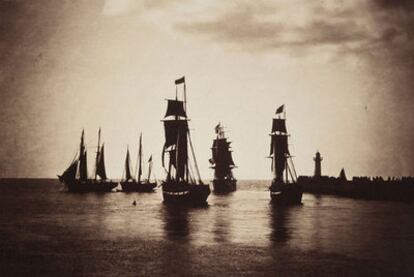The enigma of "dead-leaf yellow"
World's leading experts in the surprisingly young discipline of photographic restoration gather in the Spanish city of Logroño to discuss their trade
"Dead-leaf yellow." In the listed colors of his photographs, Frenchman Gustave Le Gray (1820-1884) found three precise words to define the sepia tone of some of his landscapes. But how do you return that hue to 150-year-old photos, which, until around three decades ago, nobody was interested in preserving?
And, above all, where is "dead-leaf yellow" in the Pantone color-matching guide? Gray was worried about the preservation of his works - that's why he made his lists - but what he couldn't have imagined is that a century and a half later his worry would be shared by a Texan millionaire, who last Saturday acquired his Bateaux quittant le port du Havre , taken in 1856 or 1857, in a Paris auction for 917,000 euro.
Photography restoration and preservation experts were gathered in Logroño this week to address such worries at the FotoConservación conference. The discipline is little more than 30 years old, having begun in 1975 with the opening of George Eastman House in Rochester (New York), and curators have yet to standardize their criteria.
"There are a multitude of photographic materials and processes; it is a young science," explains the conference's scientific director, Ángel María Fuentes. "There was an urgent need to standardize, to clarify protocols and to reconsider exhibition and conservation approaches."
The conference is divided into an international section, which closes on Thursday - where what is agreed "will serve as a working base for the future" - and a national part, which continues through Friday and Saturday. "We divide it because Spain has its own identity," says Fuentes, "and because in these times of crisis we are going to anticipate the cuts and decide the minimum scientific criteria for preservation."
The curators have a response at the ready for when the politicians arrive: "Maybe I can do without changing the covers of some photos, but there will be unavoidable preservation processes, and without them our cultural legacy will disappear."
All the big names in photography preservation are in Logroño, including Grant Romer, who worked at Eastman House at the start. Many of them put forward ideas, including Nora Kennedy of the New York Met, who urged her colleagues to talk with the artists. "We will never know how Walker Evans or Alfred Stieglitz's photos originally looked, but I could still chat to Richard Avedon about the preservation and exhibition [...] of his work. What the artists actually intended is fundamental, and even more so in contemporary photography, where many times the work is unique and there is no prior negative."

Photography first-aid
One surname drew particular attention among those of the speakers at FotoConservación: that of Anne Cartier-Bresson, niece of the legendary photographer Henri Cartier-Bresson. Having started in archeology, one day she asked herself why nobody was devoting theirefforts to preserving photographs, even though there were huge collections in France. "My uncle supported me in my studies and I spoke to him a lot about his work and archive," she says.
Anne Cartier-Bresson runs a unique institution, l'Átelier de Restauration et de Conservation des Photographies de la Ville de Paris (ARCP), a leading light in the field. Created in 1983, it serves 12 museums, seven public libraries and another seven archives around the French capital. Eight million images are under its protection.
A photograph, she insists, does not exist in isolation. "It matters a lot to me to do research in order to catalogue strictly. For example, in the Victor Hugo Museum are the photos he took, but so are his machines, his assets, his bills. It all brings information."
Tu suscripción se está usando en otro dispositivo
¿Quieres añadir otro usuario a tu suscripción?
Si continúas leyendo en este dispositivo, no se podrá leer en el otro.
FlechaTu suscripción se está usando en otro dispositivo y solo puedes acceder a EL PAÍS desde un dispositivo a la vez.
Si quieres compartir tu cuenta, cambia tu suscripción a la modalidad Premium, así podrás añadir otro usuario. Cada uno accederá con su propia cuenta de email, lo que os permitirá personalizar vuestra experiencia en EL PAÍS.
¿Tienes una suscripción de empresa? Accede aquí para contratar más cuentas.
En el caso de no saber quién está usando tu cuenta, te recomendamos cambiar tu contraseña aquí.
Si decides continuar compartiendo tu cuenta, este mensaje se mostrará en tu dispositivo y en el de la otra persona que está usando tu cuenta de forma indefinida, afectando a tu experiencia de lectura. Puedes consultar aquí los términos y condiciones de la suscripción digital.
Últimas noticias
Maduro pleads not guilty before the federal court in New York: ‘I am still the president of Venezuela’
A new test can detect Alzheimer’s from a finger prick
UN team enters Sudanese city of El Fasher after paramilitary massacre: ‘It’s like a ghost town’
A recipe for resistance: Indigenous peoples politicize their struggles from the kitchen
Most viewed
- Gilles Lipovetsky: ‘If you want to live better and fall in love, take Prozac, don’t look to philosophy’
- Alain Aspect, Nobel laureate in physics: ‘Einstein was so smart that he would have had to recognize quantum entanglement’
- Maduro’s downfall puts China’s relationship with Venezuela to the test
- Why oil has been at the center of Venezuela-US conflicts for decades
- Alvin Hellerstein, a 92-year-old judge appointed by Bill Clinton, to preside over Maduro’s trial in New York








































